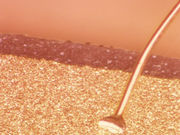White light as effective and well tolerated as daylight for photodynamic therapy
FRIDAY, Feb. 12, 2016 (HealthDay News) — For patients with actinic keratoses (AKs), artificial white light is as effective and well tolerated as daylight for photodynamic therapy (PDT), according to a study published online Feb. 3 in JAMA Dermatology.
Susan M. O’Gorman, M.B.B.Ch., from Saint Vincent’s University Hospital in Dublin, Ireland, and colleagues enrolled 22 men (median age, 72 years) with significant photodamage and a high number of AKs in a split-scalp design study. AKs were counted, mapped, and photographed in two symmetrical treatment fields at baseline, one, three, six, and nine months. Patients had half their scalp treated with daylight photodynamic therapy (DPDT) and half with artificial white light (AWL) PDT one week apart.
The researchers found that at one month, the median number and percentage of reduction in AKs per field were 12 and 62.3 percent, respectively, for DPDT, and 14 and 67.7 percent, respectively, for AWL PDT (P = 0.21 and 0.13, respectively). There were no significant between-group differences noted in the reduction percentage of AKs at one, three, six, or nine months. The median number and percentage of reduction in AKs per field were nine and 48.4 percent, respectively, for DPDT, and 12 and 64.4 percent, respectively, for AWL PDT at nine months (P = 0.13 and 0.05, respectively). Pain was reported by 14 and 16 patients with DPDT and AWL PDT, respectively (P = 0.51).
“Photodynamic therapy using an AWL source was as effective and well tolerated as daylight photodynamic therapy,” the authors write.
Copyright © 2016 HealthDay. All rights reserved.








